Bioinformatic cis-element analyses performed in Arabidopsis and rice disclose bZIP- and MYB-related binding sites as potential AuxRE-coupling elements in auxin-mediated transcription
- PMID: 22852874
- PMCID: PMC3438128
- DOI: 10.1186/1471-2229-12-125
Bioinformatic cis-element analyses performed in Arabidopsis and rice disclose bZIP- and MYB-related binding sites as potential AuxRE-coupling elements in auxin-mediated transcription
Abstract
Background: In higher plants, a diverse array of developmental and growth-related processes is regulated by the plant hormone auxin. Recent publications have proposed that besides the well-characterized Auxin Response Factors (ARFs) that bind Auxin Response Elements (AuxREs), also members of the bZIP- and MYB-transcription factor (TF) families participate in transcriptional control of auxin-regulated genes via bZIP Response Elements (ZREs) or Myb Response Elements (MREs), respectively.
Results: Applying a novel bioinformatic algorithm, we demonstrate on a genome-wide scale that singular motifs or composite modules of AuxREs, ZREs, MREs but also of MYC2 related elements are significantly enriched in promoters of auxin-inducible genes. Despite considerable, species-specific differences in the genome structure in terms of the GC content, this enrichment is generally conserved in dicot (Arabidopsis thaliana) and monocot (Oryza sativa) model plants. Moreover, an enrichment of defined composite modules has been observed in selected auxin-related gene families. Consistently, a bipartite module, which encompasses a bZIP-associated G-box Related Element (GRE) and an AuxRE motif, has been found to be highly enriched. Making use of transient reporter studies in protoplasts, these findings were experimentally confirmed, demonstrating that GREs functionally interact with AuxREs in regulating auxin-mediated transcription.
Conclusions: Using genome-wide bioinformatic analyses, evolutionary conserved motifs have been defined which potentially function as AuxRE-dependent coupling elements to establish auxin-specific expression patterns. Based on these findings, experimental approaches can be designed to broaden our understanding of combinatorial, auxin-controlled gene regulation.
Figures





Similar articles
-
Computational analysis of auxin responsive elements in the Arabidopsis thaliana L. genome.BMC Genomics. 2014;15 Suppl 12(Suppl 12):S4. doi: 10.1186/1471-2164-15-S12-S4. Epub 2014 Dec 19. BMC Genomics. 2014. PMID: 25563792 Free PMC article.
-
Prediction of auxin response elements based on data fusion in Arabidopsis thaliana.Mol Biol Rep. 2018 Oct;45(5):763-772. doi: 10.1007/s11033-018-4216-6. Epub 2018 Jun 23. Mol Biol Rep. 2018. PMID: 29936576
-
Diversity of cis-regulatory elements associated with auxin response in Arabidopsis thaliana.J Exp Bot. 2018 Jan 4;69(2):329-339. doi: 10.1093/jxb/erx254. J Exp Bot. 2018. PMID: 28992117 Free PMC article. Review.
-
Meta-analysis of transcriptome data identified TGTCNN motif variants associated with the response to plant hormone auxin in Arabidopsis thaliana L.J Bioinform Comput Biol. 2016 Apr;14(2):1641009. doi: 10.1142/S0219720016410092. J Bioinform Comput Biol. 2016. PMID: 27122321
-
Auxin response factors.Curr Opin Plant Biol. 2007 Oct;10(5):453-60. doi: 10.1016/j.pbi.2007.08.014. Epub 2007 Sep 27. Curr Opin Plant Biol. 2007. PMID: 17900969 Review.
Cited by
-
Identification of the SUT Gene Family in Pomegranate (Punica granatum L.) and Functional Analysis of PgL0145810.1.Int J Mol Sci. 2020 Sep 10;21(18):6608. doi: 10.3390/ijms21186608. Int J Mol Sci. 2020. PMID: 32927615 Free PMC article.
-
Genome-wide identification and expression profiling analysis of the Aux/IAA gene family in Medicago truncatula during the early phase of Sinorhizobium meliloti infection.PLoS One. 2014 Sep 16;9(9):e107495. doi: 10.1371/journal.pone.0107495. eCollection 2014. PLoS One. 2014. PMID: 25226164 Free PMC article.
-
Identification of Candidate Transcriptional Regulators of Epidermal Transfer Cell Development in Vicia faba Cotyledons.Front Plant Sci. 2016 May 25;7:717. doi: 10.3389/fpls.2016.00717. eCollection 2016. Front Plant Sci. 2016. PMID: 27252730 Free PMC article.
-
Dempster-Shafer Theory for the Prediction of Auxin-Response Elements (AuxREs) in Plant Genomes.Biomed Res Int. 2018 Nov 1;2018:3837060. doi: 10.1155/2018/3837060. eCollection 2018. Biomed Res Int. 2018. PMID: 30515394 Free PMC article.
-
The HD-ZIP II Transcription Factors Regulate Plant Architecture through the Auxin Pathway.Int J Mol Sci. 2020 May 4;21(9):3250. doi: 10.3390/ijms21093250. Int J Mol Sci. 2020. PMID: 32375344 Free PMC article.
References
-
- Bennett T, Scheres B. Root development-two meristems for the price of one? Curr Top Dev Biol. 2010;91:67–102. - PubMed
Publication types
MeSH terms
Substances
LinkOut - more resources
Full Text Sources
Miscellaneous

